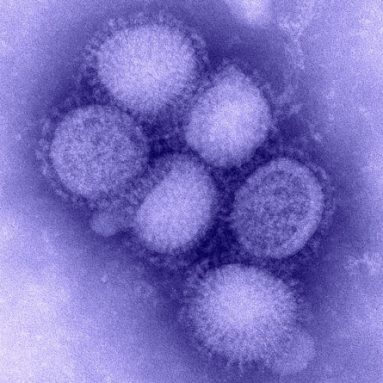Swine flu goes global
The disease is likely to keep spreading, but a vaccine may be in sight
 |
|
The H1N1 flu virus, shown here, has been called swine flu because scientists suspect it started out in pigs. Despite its name, the H1N1 flu can’t be caught by eating pork products or being near pigs.
|
| CDC |
If you live in the United States, it’s likely that swine flu has been found in your state.
As of May 5, 403 people in 38 states have been diagnosed with an infection caused by a novel influenza A (H1N1) virus. This infection is commonly known as the swine flu. The number of infected people is likely to increase, according to the Centers for Disease Control (CDC), an Atlanta-based government office that investigates the spread of disease. One person has died in the United States, and hundreds of people have died from the infection in Mexico.
The H1N1 flu has been called swine flu because scientists suspect it started out in pigs. Despite its name, the H1N1 flu can’t be caught by eating pork products or being near pigs.
The H1N1 flu is not just a problem in North America. Worldwide, more than 1,000 cases have been reported in 21 countries, according to the World Health Organization (WHO) on May 5. WHO is the United Nations office responsible for keeping an eye on global health
matters like widespread disease. Continents where the disease has been reported also include Europe, South America and Asia.
Officials at WHO say the disease is probably not going to slow down any time soon. On April 29, the organization issued a warning that the spread of H1N1 may lead to a pandemic, when a disease occurs in many different areas and affects a large part of the population. “That puts countries on high alert for influenza and pneumonia,” said Margaret Chan, the Director-General of WHO, during a press conference on April 29.
Like other kinds of flu, the H1N1 flu is caused by a virus. A virus is tiny and made of a protein shell and genetic material. Viruses can cause disease, and they spread easily from person to person. But viruses need a cell to grow in. Once inside your body, a virus can cause an infection by invading healthy cells. The genetic material inside the virus is a set of instructions that causes your healthy cells to make new virus particles.
Scientists at the CDC have been studying the H1N1 virus to try to understand what makes it tick. On May 1, they reported some good news. “All of the genes of all the viruses we’ve examined are 99 to 100 percent identical,” says Nancy Cox, chief of the influenza division at the CDC. “This means it will be somewhat easier to produce an influenza vaccine.”
A vaccine is a medicine that can help prevent a virus from causing infection. Vaccines are often made from tiny bits of the virus itself. People who received a flu shot — which is a vaccination against many types of influenza — are not protected against H1N1 though. Some antiviral flu drugs have been shown to help people who are infected, as long as they take the medicine within two days of when symptoms first appeared.
Even if scientists are closer to a vaccine, they won’t be able to produce one for several months. Cox estimates it will take at least three more weeks for scientists to study the virus, and another eight to 10 weeks to make the vaccine.
Power words:
Vaccine: A preparation of a weakened or killed pathogen, such as a bacterium or virus. Upon
administration, a vaccine stimulates antibody production or cellular immunity
against the pathogen.
Pandemic: A disease over a wide geographic area that affects a large proportion of the
population.
Influenza: A contagious viral infection characterized by inflammation of the respiratory tract and by
fever, chills, muscular pain and exhaustion.
Virus: A simple submicroscopic (can’t be seen with a microscope) parasite of plants, animals
and bacteria. A virus often causes disease and consists of a core of RNA or DNA,
a kind of genetic material, surrounded by a protein coat.
Going Deeper:







